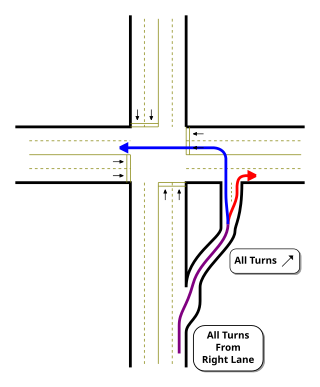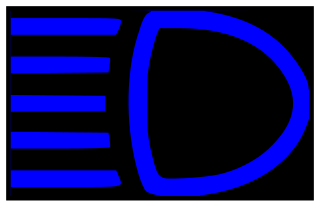
Traffic comprises pedestrians, vehicles, ridden or herded animals, trains, and other conveyances that use public ways (roads/sidewalks) for travel and transportation.

An intersection or an at-grade junction is a junction where two or more roads converge, diverge, meet or cross at the same height, as opposed to an interchange, which uses bridges or tunnels to separate different roads. Major intersections are often delineated by gores and may be classified by road segments, traffic controls and lane design.

A three-way junction is a type of road intersection with three arms. A Y junction generally has three arms of equal size coming at an acute or obtuse angle to each other; while a T junction also has three arms, but one of the arms is generally a smaller road joining a larger road at right angle.

Traffic lights, traffic signals, or stoplights – also known as robots in South Africa and Namibia – are signalling devices positioned at road intersections, pedestrian crossings, and other locations in order to control the flow of traffic.

In road transport, a lane is part of a roadway that is designated to be used by a single line of vehicles to control and guide drivers and reduce traffic conflicts. Most public roads (highways) have at least two lanes, one for traffic in each direction, separated by lane markings. On multilane roadways and busier two-lane roads, lanes are designated with road surface markings. Major highways often have two multi-lane roadways separated by a median.

A single-point urban interchange, also called a single-point interchange (SPI) or single-point diamond interchange (SPDI), is a type of highway interchange. The design was created in order to help move large volumes of traffic through limited amounts of space efficiently.

A jughandle is a type of ramp or slip road that changes the way traffic turns left at an at-grade intersection. Instead of a standard left turn being made from the left lane, left-turning traffic uses a ramp on the right side of the road. In a standard forward jughandle or near-side jughandle, the ramp leaves before the intersection, and left-turning traffic turns left off of it rather than the through road; right turns are also made using the jughandle. In a reverse jughandle or far-side jughandle, the ramp leaves after the intersection, and left-turning traffic loops around to the right and merges with the crossroad before the intersection.

A hook turn or two-stage turn, also known as a Copenhagen Left, is a road cycling manoeuvre or a motor vehicle traffic-control mechanism in which vehicles that would normally turn from the innermost lane of an intersection instead turn from the outermost lane, across all other lanes of traffic.

Overtaking or passing is the act of one vehicle going past another slower moving vehicle, travelling in the same direction, on a road. The lane used for overtaking another vehicle is often a passing lane farther from the road shoulder, which is to the left in places that drive on the right and to the right in places that drive on the left.

A motor vehicle has lighting and signaling devices mounted to or integrated into its front, rear, sides, and, in some cases, top. Various devices have the dual function of illuminating the road ahead for the driver, and making the vehicle visible to others, with indications to them of turning, slowing or stopping, etc., with lights also indicating the size of some large vehicles.

Road signs in Sweden are regulated in Vägmärkesförordningen, VMF (2007:90), and are to be placed 2 metres from the road with the sign 1.6 m from the base for motorized roads. Except for route numbers, there are a maximum of three signs on a pole, with the most important sign at the top. All signs have a reflective layer added on selected parts of the sign as is custom in European countries; most larger signs also have their own illumination.

Turn on red is a principle of law permitting vehicles at a traffic light showing a red signal to turn into the direction of traffic nearer to them when the way is clear, without having to wait for a green signal.
The yellow trap is a potentially dangerous scenario relating to turns at a traffic light-controlled intersection across oncoming traffic without a protective turn signal; for right-hand traffic, this refers to a vehicle attempting to make a left turn without a permissive/protective left-turn signal.

In traffic engineering, there are regional and national variations in traffic light operation. This may be in the standard traffic light sequence or by the use of special signals.

An all-way stop – also known as a four-way stop – is a traffic management system which requires vehicles on all the approaches to a road intersection to stop at the intersection before proceeding through it. Designed for use at low traffic-volume locations, the arrangement is common in the United States, Canada, Mexico, South Africa, and Liberia, as well as in a number of, usually rural, locations in Australia where visibility on the junction approaches is particularly poor. The stop signs at such intersections may be supplemented with additional plates stating the number of approaches.

A seagull intersection or continuous green T-intersection is a type of three-way road intersection, usually used on high traffic volume roads and dual carriageways. This form of intersection is popular in Australia and New Zealand, and sometimes used in the United States and other countries.

Headlight flashing is the act of either briefly switching on the headlights of a car, or of momentarily switching between a headlight's high beams and low beams, in an effort to communicate with another driver or drivers. The signal is sometimes referred to in car manufacturers' manuals as an optical horn, since it draws the attention of other drivers.

A protected intersection or protected junction, also known as a Dutch-style junction, is a type of at-grade road junction in which cyclists and pedestrians are separated from cars. The primary aim of junction protection is to help pedestrians and cyclists be and feel safer at road junctions.

Terminology related to road transport—the transport of passengers or goods on paved routes between places—is diverse, with variation between dialects of English. There may also be regional differences within a single country, and some terms differ based on the side of the road traffic drives on. This glossary is an alphabetical listing of road transport terms.
Traffic lights – devices positioned at road intersections, pedestrian crossings and other locations – control flows of traffic with social norms and laws created by the state. Traffic signals have to convey messages to drivers in a short period of time about constantly-changing road rules.




















